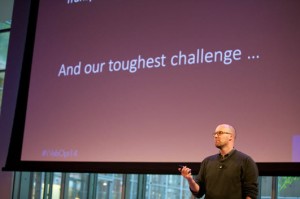Content Marketing: Harvard Business School’s Michael Norton discusses surprising consumer behavior research
I am a skeptic. Maybe it’s from my career in marketing, advertising and editorial content, which involves me constantly receiving PR pitches. Maybe I was born that way. Or maybe I’m just your average American consumer.
Whatever the cause, it’s rare for me to have a head-smacking epiphany, but here’s one I want to share with you:
People don’t want fast
This subhead likely seems counterintuitive (or perhaps just plain wrong) to you.
After all, if you’ve ever been in traffic, or in a long line at a fast food restaurant, or anywhere in America for the past 30 years, you know – people are impatient.
As Louis C.K. says in his very funny bit about people who don’t appreciate how amazing smartphone technology is, “I never saw a person going, ‘Look at what my phone can do!’ Nobody does that. They all go, ‘This ******* thing sucks. I can’t get it to … ’ Give it a second, would ya? Could ya give it a second? It’s going to space, could you give it a second to get back from space? Is the speed of light too slow for you?”
Even when I search Louis C.K on Google, the search engine brags that is has returned 45,700,000 results in 0.61 seconds.
Wow. The entirety of human knowledge for millennia is at our fingertips and can be delivered within milliseconds, and yet, as Louis so accurately points out, most of your customers do not appreciate it.
Why? More importantly, how can you as a marketer use this lesson to communicate the value of your own products?
They want hard work (on their behalf)
This is where Michael Norton’s research gets very interesting for marketers (and, really, all humans). Michael is an associate professor at Harvard, and during his Web Optimization Summit featured session — “Trust Through Transparency” — he showed that, in many cases, people place a higher value on understanding the work involved to create a product or service than they do on sheer speed.
After he got off stage, and right before hopping on the train back to Harvard, Michael was gracious enough to let me pull him aside and ask a few questions to help marketers use his research to better communicate the value of their products and services.
We discussed:
- How showing the work involved in creating content (for example, email list signup) can make that content more valuable to customers
- How to make sure customers understand the complexity behind seemingly simple services
- The power of storytelling









